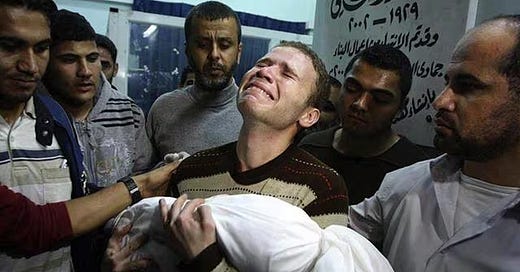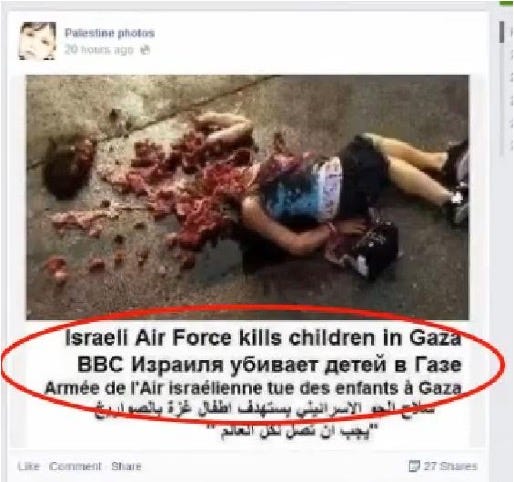I thought I’d seen just about every injustice toward Israel in the American press. But even I was shocked by the November 15th, 2012, edition of The Washington Post. Over the fold on the front page, was a color photograph of a Palestinian man holding a shrouded bundle. Around him stood several Palestinian men, each with a similarly anguished expression. The photograph appeared on the fifth day of Operation Pillar of Defense as the IDF responded to massive Hamas rocket fire from Gaza.
Predictably, Israel began their operation with a modicum of media sympathy, but this swiftly dissipated in the face of “Palestinian suffering.” Still, the photo splashed across the cover of The Washington Post was devastating:
The caption was even worse. “Jihad Masharawi weeps while he holds the body of his 11-month old son Ahmad” it read, “following an Israeli air strike on their family house in Gaza City.”
The Washington Post, relatively speaking, was not known to be overly critical of Israel. Its editor, the late Fred Hiatt, Harvard educated and proudly Jewish, was friendly to the Israeli Embassy in Washington where I was serving as ambassador.
Opening the paper that morning, I immediately called him and shouted, “What are you doing, Fred? This photo will kill us.”
He calmly explained that he was running a newspaper and the fighting in Gaza was front page news. I asked him if he knew whether the photograph was genuine.
“We don’t know what’s in that bundle,” I said, “are you sure there’s a real baby in there, and if yes, are you sure of how it was killed?” The men’s expressions were too uniform and the way they stood was too well-framed. I pressed him: “Are you confident that the photograph wasn’t faked?”
Fred replied that the paper received the photo from the Associated Press which vouched for its veracity. “We’re 100% sure it’s real.”
But it wasn’t. Three weeks later an independent investigation determined that the infant was killed by a short-fired Palestinian rocket. Israeli analysts further concluded that the entire scene was staged.
The Washington Post printed an apology, sort of, predictably on the back page. But the damage to Israel was already done.
Two years later, during Israel’s 2014 Operation Protective Edge, Hamas flooded the web with false images of Israeli atrocities. Among the most graphic was the following (trigger warning):
Internet student volunteers at IDC Herzliya (now, Reichman University) discovered this and many more horrific images – all cropped from zombie movies.
As I emphasize in these, and future Clarity pieces, our enemies use the media as a central, if not principal, battlefield in their efforts to destroy Israel. The topography of that battlefield could not be more accommodating to the terrorists. With few exceptions, the international press gives equal weight to Hamas’s word and Israel’s – though Israel’s word is exactingly documented. Few journalists will fact-check images or statistics produced by Hamas while subjecting Israel’s to microscopic scrutiny. The burden of proof falls exclusively and invariably on Israel.
I felt that burden personally on the night of October 12th. Following Secretary of State Blinken’s visit to Israel and his mention of beheaded babies, my cell phone was flooded with press inquiries. Was Blinken perpetuating an Israeli lie? So intense was the questioning that Israel was forced to violate its longstanding moral prohibition against publishing the faces of our dead. The pictures were shocking and haunting in the extreme. And yet, the internet remained rife with claims that the photos were AI produced.
And still the injustice continued. The New York Times has spent much of the past few days struggling to uphold to Hamas’s unsubstantiated claim that Israel bombed the Al-Ahli Hospital while trying to pick apart the hard evidence of Palestinian culpability adduced by both Israel and the United States. But the Times was not satisfied with rushing to vilify Israel verbally. Beneath the headline accusing Israel of “killing hundreds” it published a photograph of a bombed-out building which readers would naturally assume was the hospital
This was a double lie – Israeli sources said that not more than fifty were killed, and the image was not of the Al-Ahli Hospital. A glimpse at the caption revealed that the image was of a completely different building in a totally different location.
What difference is there, really, between the editors of The New York Times and those posting zombie pictures?
Confidential sources have told me that the accusations of Israeli guilt for the Al-Ahli bombing contributed to the government’s decision to delay the IDF’s ground incursion into Gaza. Even when false, photographs can have a far-reaching, deleterious impact.
Of course, not all journalists are out to get us. But whether they’re for or against the Jewish State, they’re in the business of media. And media needs customers. They need most lurid, eye-catching, click-baiting stories, and are fearful that some other outlet will steal their scoop. In the never-ending 24-hour news cycle, where fast is more important than fact, few journalists can afford to take the time and effort to verify a source. Hamas can issue accusations within seconds; the IDF is duty-bound to investigate, which takes time. And the quickest way for a correspondent to get evicted from Gaza at gunpoint is to question the truthfulness of a Hamas spokesman.
As Hamas, Palestinian Islamic Jihad, and Hezbollah all know, a picture can tell a thousand lies. Lies that can alter international opinion and impair Israel’s ability to defend itself. Lies that can endanger the safety of millions of Jews worldwide.
Photographs are not the only form of Hamas lies, unfortunately. Cyabra, the intrepid Israeli social media intelligence company, estimates that in the 24 hours after the alleged hospital bombing, over 43 million X (formerly Twitter) users were exposed to misleading posts on the subject generated by anti-Israel bots.
In a world inundated with lies, the job of those who care about Israel is to separate them from the truth. Our job is to determine whether a photograph is real or just another attempt to delegitimize us. Next time you see a photograph like this, taken by the Times’ Samar Abu Elouf:
Remember the full page photo of the grieving father on the front page of the Washington Post over a decade ago. Ask if the image is truly Israel’s fault – or just another Hamas lie.
This is the third of a multi-part, up-to-the minute Clarity report from the media front of the Gaza War. Click here for Part I and here for Part II








In her October 20 opinion piece, Michelle Goldberg said the proverbial quiet part out loud (and, oddly, each of my attempts to quote it and ask about it in the comments section was never published). She wrote, “Of course, I’d read Israel’s insistence that an errant Islamic Jihad rocket had caused the explosion at the hospital, but I didn’t put much stock in it, because in the past when Israel accidentally killed civilians, it has blamed Palestinians for the deaths.” In a nutshell, this is the newsroom bias that allows for the immediate and unverified publication of “information” from a news source (Hamas) that has a proven track record of providing at best unreliable and often false information and a genocidal agenda of which it boasts openly.
Goldberg then retreats behind a predictable defense of fog of war and uncertainty - yet that in no way answers why the rush to publish a story that, if it turned out to be wrong, would further inflame the region as it has. As with the phony AP photograph, when the truth comes out, it is buried at best. Most often, the media reacts as if its journalistic malpractice never occurred. In the case of the BBC, when one of its correspondent’s concludes “that it is hard to see what else it could be than an Israeli air strike or multiple strikes”, the BBC defended on the grounds that he did not conclude that it actually was an Israeli air strike. Who knew the BBC engaged in such Jesuitical parsing?
The Hamas Hospital Hoax, a story in which (to borrow Mary McCarthy’s put down of Lilian Hellman) every word was a lie including “and” and “the”, should be a wake up call to the media as the utter depravity of Hamas’ October 7 massacres should be. But, given time, the old narratives will reappear and the groundwork is now being laid with the myth of the innocent Gazan who secretly objects to Hamas but cannot do anything about it. Gone from the discussion is the fact that Hamas remains the most popular Palestinian group (its popularity only increased as a result of its barbarity), forgotten is that Abbas has refused to hold elections since 2006 precisely because of Hamas’ popularity. Ignored, as always, is the uncomfortable fact that Hamas and the PA share the same eliminationalist goal of destroying Israel, they only disagree on tactics and timing with the PA adhering to Arafat’s “phased strategy,”
My view: once the Palestinians put forward a Konrad Adenauer who believes in a “two states for two peoples”” resolution, I might consider this myth as worth swallowing. Until then, the Gazans in particular and Palestinians generally need to be held to account in a way post-WWII Germans were not.